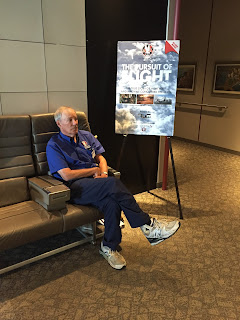Saturday, August 29, 2015
Friday, August 28, 2015
Friday, August 21, 2015
A Flight Engineer's panel on the Boeing 707.
Flight Engineer - A Dying Breed
I had the opportunity to ride the jumpseat on one of our 727s recently. Watching the Flight Engineer go about his job, I was reminded of just how busy that job could be.Flight Engineers are a rare breed these days and won't be around much longer. Flying as a passenger, you probably haven't seen one in 10 years or so. The passenger airlines retired their three-person aircraft years ago and even the freight carriers are phasing out their 727s, DC-8s and 747 "Classics". When we retire the last of our 727s that will be it for our Engineers.
Many in the airline business started out their careers as Flight Engineers, also called Second Officers (a holdover from back when airliners had larger crews).
I am no exception, my first introduction to airline life was as an Engineer on the 727
An interesting story. about ORD....Chicago
|
|
|
|
Thursday, August 20, 2015
Tuesday, August 18, 2015
Inside the CR Smith museum.
Plan Your 2015 Holiday Event
at the C.R. Smith Museum
and save 10% if you book
by September 18th
Contact: Shane Melvin at 817-967-5910 or Shane.Melvin@aa.com
Saturday, August 15, 2015
The dime on the tail of the DC-3 story is forth comming!!!
A year or so ago I was standing near the DC-3 and a gentleman comes up to me and asks if I was familiar with the coin under the DC-3?
Needless to say I had no idea of what he was referring to.
He went on to say when these type planes were manufactured by Donald Douglas his mechanics would rivet a dime under the fuselage
near the tail,in case " you bought the farm" (crashed) and survived you had a dime to call for help. He went on his way and as soon as he was out of sight I just has to look. Sure enough there was the dime riveted near the tail. (you have the picture of ours)
In October of that year I was visiting my son in Florida and there was an air show at the Stuart airport. The Flagship Detroit was there and I asked one of the AA people showing the aircraft if he had ever heard the story of the dime riveted to the aircraft. He had no knowledge of what I was talking about. I asked him if I could crawl under and take a look.. No dime there BUT in the exact spot where it would have been there was a piece of aluminum about 2 inches square riveted to the aircraft. To me it looked like someone removed it and patched the hole.
Several years ago I met the sons of Donald Douglas,Don and Jim. Had I known about the dime at the time I would have asked them and I bet they would have had the answer.
I have no idea if there is any truth to this but the dime is there on our DC-3.
Don Smith
Friday, August 14, 2015
Thursday, August 13, 2015
Top of the Wright 3350 engine.
It's the air inlet for the fuel injection.
Our Wright 3350 Engine
This is the powerful 3,400 horsepower Curtis-Wright
R3350/TC18 engine which was donated by the Golden Wings, an association
of professional Flight Engineers in about 1991 and powered our Douglas
DC-7 aircraft.
It was the last type of reciprocating engines
purchased by American Airlines and the most challenging one for flight
engineers because it was so complex.
Marsh Stern, Golden Wings President at the time,
raised $35,000 through donations from active and retired Flight
Engineers. Acquisition and restoration was managed by Golden Wings
member Don Williams and parts procurement by AAer Jim Connaughton,
a Phoenix based line mechanic.
Because none of American’s original DC-7 engines
survived, the organization purchased a similar engine from a later
SABENA DC-7C and Williams modified it to the DC-7 Standards.
You will note that ours sits on a mirror and some
would not recognize it as a TC18 engine as there was always a puddle of
oil under the engine while at rest.
When introduced in 1953, American’s four engine DC-7s were the first to fly non-stop service coast-to-coast in both directions.
Their careers were cut short by the advent of jets
and the last of AA’s DC-7s became freighters and were eventually retire
in 1966.
Wednesday, August 12, 2015
Subscribe to:
Posts (Atom)

















































